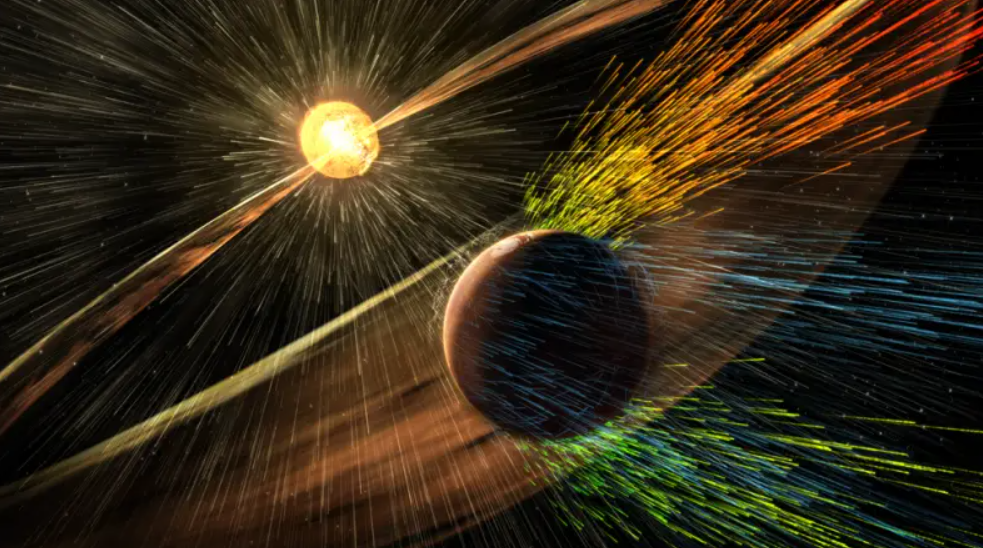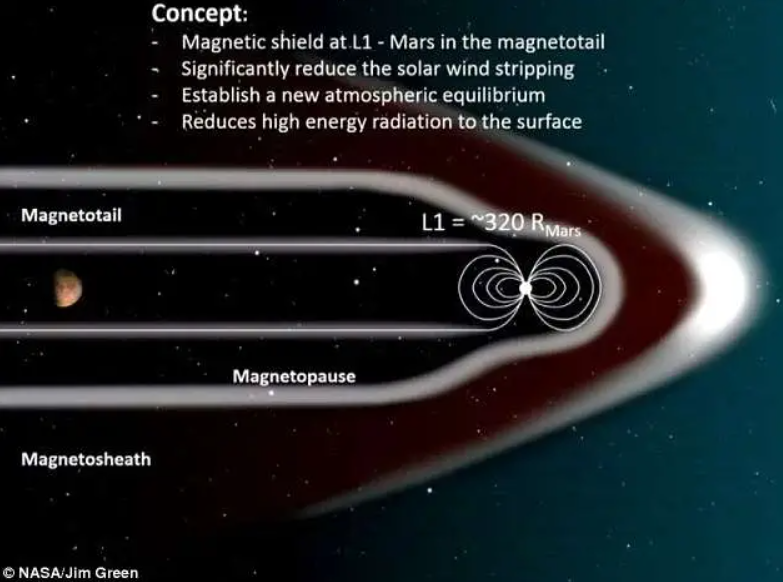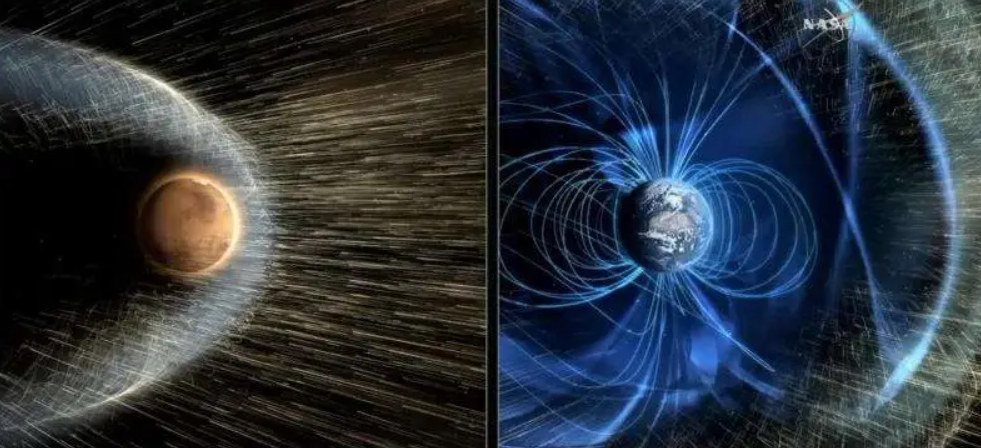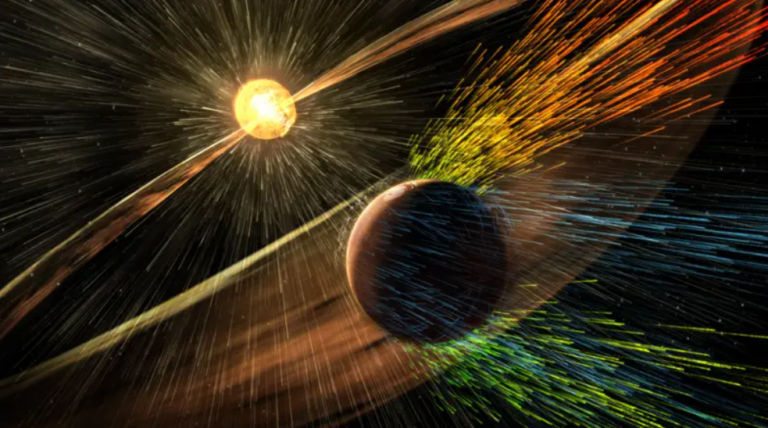NASA Proposes a Magnetic Shield to Protect Mars’ Atmosphere
NASA Plans to Use a Magnetic Shield to Help Restore Mars’ Atmosphere and Support Human Missions
NASA has suggested capturing and depositing a magnetic shield over the Mars in order to rebuild the red planet’s atmosphere and enable colonization by the 2030s. This shield would be located at the Mars L1 Point orbit to prevent the planet from being subjected to the tendency of continuous force from the solar winds so as to give the planet’s atmosphere time to thicken. Perhaps after millions of years this would warm the planet, melt the ice caps, gain back some of it’s water and create a more habitable conditions for man.
In August the Planetary Science Division (PSD) of NASA conducted the “Planetary Science Vision 2050 Workshop” at the NASA headquarters in Washington D. C. It also convened scientific and research experts from different part of the globe to deliberate on futurity of manned space explorations.
A presentation, which attracted considerable attention, was the one dedicated to exploring the Mars using astronauts. In his presentation called “A Future Mars Environment for Science and Exploration” during the recent conference, the NASA Director Jim Green said that sending a magnetic field could bolster Mars’ atmosphere in preparation for possible humans mission there.
This is true: today, the mainstream model of Mars anthropogeny, among other things, claims that Mars, like Earth, eventually had a shielded magnetic field. However, around 4. About 2 billions years ago Martian magnetic field disappeared and most of the Martian’ atmosphere went out into space with interesting consequences. In the course of 500 million years, Mars evolved from a warm and rather moist planet to a cold barren planet as it is today.

This theory has been passed on by data gathered by orbiters such as Mars Express belonging to the European Space Agency, and MAVEN belonging to NASA and has been studying the Martian atmosphere since 2004 and 2014. These missions have given confirmation that solar wind played a big part as to why Mars has lost most of its atmosphere and is still eroding away at today’s rate.
Without such shield, Mars retains the conditions of a frigid desert where life cannot exist, as we know it. This also poses significant difficulties to future crewed missions that are scheduled by NASA in the 2030 s because the astronauts would be in serious dangers from radiation or the risk of suffocation and if it is portrayed to potential colonists, it become more difficult.
In order to mitigate these risks, Dr. Jim Green and a team of researchers had one idea that seemed ambitious. They proposed that using a magnetic dipole shield placed at the Mars L1 Lagrange Point can provide the Mars with an artificial magnetosphere and protect it from the Solar wind and Radioactive radiation.
While Green and his team admit the idea may sound ‘fanciful,’ the researcher noted that fresh studies on small magnetospheres meant to shield spacecrafts and crews give credence to the theory.

“There is this new research coming up because of versatility in plasma physics and extensions in lab based experiments tomorrow inflatable structures might be able to induce magnetic dipole field of 1 to 2 Tesla (10,000 to 20,000 Gauss) and that will help in shielding against event as specialty as solar wind. ”
placing this magnetic shield would protect two areas where Mars’ upper atmosphere is currently being lost to space. While presenting their findings, Green and his team pointed out that these escape routes were available “above the northern polar cap, involving high-energy ionospheric particles and in the equatorial region, where low-energy oxygen ions were escaping at the rate of 0. 1kg/s. ”
Before attempting the real thing, the research team from Ames Research Center, Goddard Space Flight Center, University of Colorado, Princeton University, and the Rutherford Appleton Laboratory used the Coordinated Community Modeling Center, a space weather modeling environment, to make the simulation. : These simulations assessed impacts of the artificially imposed magnetosphere as suggested here.
According to their studies, the structures used could alter the Mars’ magnetic field to a dipole field at the Mars L1 Lagrange Point effectively shielding the planet from the solar wind. In the present epoch Mars’ interior and crust outgass disjointedly and supplement only partially the atmosphere, which now measures around 6 mbar of air pressure, or less than 1% of the sea-level pressure on Earth.

Hence, the Mars’ atmosphere would become denser over time making it even more viable for man to explore and even colonize the planet. And so Green reckoned that the temperature could grow to roughly 4 C (7 F), which would be sufficient to unfreeze the carbon dioxide ice and the northern polar ice cap. This would merely promote another greenhouse effect and increase the temperature of the planet and as a result, the water ice in the polar caps would begin to melt.
Accordingly, the above-stated alterations should be able to bring back approximately one-seventh of the oceans, Mars once had billions of years back. It’s a little similar to the early stages of terraforming, only such alterations would greatly help human missions in the decades to come.
“More pressure, temperature, and, therefore more of the gas itself on the surface can support liquid water and hold many scientific and manned mission benefits for the 2040s and beyond,“ added Green. “As on Earth, the denser atmosphere would permit heavier equipment to land, shield from cosmic and solar radiation, help in extraction of oxygen and feature ‘outdoor’ spots for growing plants, among others. ”
These improved conditions would also mean that the scientists would be able to undertake better investigation of Mars, including the assessment of its possible inhabitants since the traces of water and early life start to reveal themselves. This could however be achieved in the next coming decades in the prospect of future colonization of Mars.
At the same time, Green and his team are working on increasing the accuracy of their simulation results in order to come up with more exact dates when these changes can be expected. Further analysis that would also make sense would be cost evaluations for the shield made of magnetic material. It though taking this idea as a concept of futuristic idea, let us not forget that at least counting is definitely a good start!
Do not forget to share your opinion with us to provide you with the best posts !




0 Comments